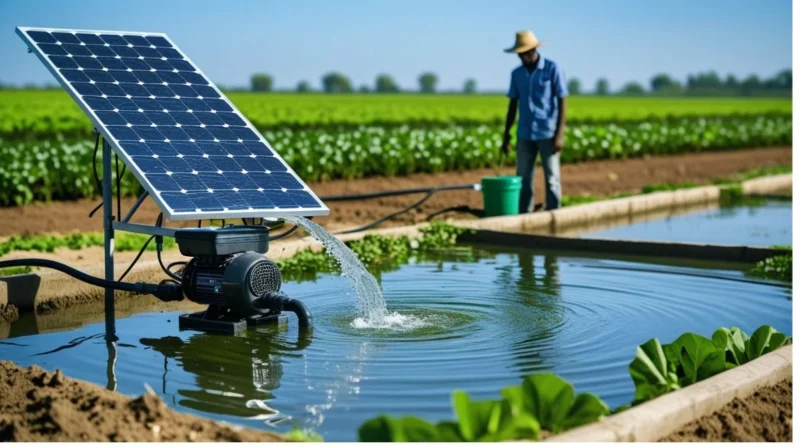Table of Contents
Solar power for pumping water uses sunlight instead of fuel or grid electricity to move water for farms, homes, and communities. This clean and affordable solution is gaining popularity around the world for good reasons. In this guide, you’ll find easy explanations of how it works, its benefits and drawbacks, real‑life examples, and tips to decide if it fits your needs.
How Solar Water Pumps Work?
A solar water pump system has five key parts:
- Solar panels (PV): Collect sunlight and convert photons into electrical energy.
- Inverter/controller: Converts DC power from panels into AC if needed, and regulates flow.
- Pump motor: This can be submersible or surface-mounted, and pushes water from wells or lakes.
- Pipes & storage tank: Carry water to where it’s needed and hold an extra supply for cloudy times.
- Float switch or controller: Turns the pump on/off to protect it from running dry or overworking.
When sunlight hits the panels, electricity powers the pump. If AC is needed, the inverter converts current. Controllers automate pumping and protect the system.
Benefits of Solar Water Pumps
Free Operation Costs
Solar panels run on sunlight, meaning no fuel costs ever. Over time, you save money compared to petrol or diesel pumps.
Minimal Maintenance
Maintenance is simple with few moving parts and no engine oil or filters. Just keep panels clean and check basic wiring.
Eco‑Friendly
No greenhouse gas emissions while operating. Unlike fossil fuel pumps, solar systems don’t pollute the air or water.
Works Anywhere with Sunlight
Great for remote areas without grid access, no need for fuel deliveries or power lines.
Boosts Productivity
Farmers save time, and water access becomes reliable. Communities can irrigate more easily and improve food production.
Long Lifespan
Solar panels can last 25+ years, and pumps typically run 10–20 years with proper care.
Scalable and Flexible
You can use small DC pumps for gardens or large AC pumps for farms. Systems adapt easily.
Drawbacks & How to Manage Them
Higher Upfront Cost
Solar pumps cost more to install than diesel or grid-based options. But as panel prices drop, long‑term savings make them worthwhile.
Sunlight Dependent
The pump won’t run without storage tanks or batteries if it’s cloudy or at night. Typically, users fill tanks during the day for later use.
Water Storage Needs
Because pumps only work when the sun shines, larger tanks are needed to hold enough water for off-sun hours.
Risk of Theft
In some areas, solar panels may get stolen. It’s wise to secure the panels on secure frames and in lockable rooms.
Over‑Extraction Risk
Unlimited pumping can deplete groundwater. It’s smart to test aquifers and run pumps responsibly.
Real‑World Examples
- Haryana, India: The state installed 154,000 solar water pumps, reducing power grid load by 822 MW.
- South Wales, Australia: Replacing old windmills with solar pumps brought remote monitoring, safer operation, and less maintenance.
- African villages: Groups like Innovation: Africa built systems pumping up to 30,000 L per day, benefiting 10,000 people per village by training local operators.
- Guardian Alert in Africa: Experts stress that while solar pumps are helpful, they must include plans to manage groundwater usage and match systems to geology.
Choosing the Right System
- Find your water source: Will you pump from a borehole, lake, or canal? Check groundwater levels and yield.
- Estimate your needs: How much water do you use daily? Size your pump and storage accordingly.
- Pick pump type: DC pumps are efficient for smaller flows. AC pumps with inverters are better for bigger setups
- Plan storage: Add a tank for off-hours use. If needed, include a small battery or hybrid system.
- Protect your system: Secure panels, add fences, and use controllers to stop dry-running or overflow.
- Local support: Choose components with local parts and technicians, especially for repairs.
Smart Tips
- Clean panels regularly for peak performance.
- Monitor water output; a dip might signal issues.
- Test water levels yearly to avoid depletion.
- Consider economic incentives: India’s PM‑KUSUM scheme offers up to 60% subsidy on solar pumps.
Future Trends
- Solar canals: Covering irrigation canals with panels saves water and runs pumps directly from clean energy.
- Cooling effect: Panels over canals stay cooler, boosting energy output while reducing evaporation.
- Groundwater mapping: Better technology helps match pump systems to geology, promoting sustainability.
Conclusion
Solar power for pumping water is a clean, smart choice, especially in sunny, remote places. While the start‑up cost may be higher, the benefits, no fuel expenses, low maintenance, no pollution, and happier farms, make it worth it. Planning smartly with storage, security, water testing, and local support ensures a reliable system. Switching to solar water pumps is more than just a trend; it’s a sustainable solution that boosts food production, saves money, and protects the planet. If you’re thinking about adding one, research carefully, size it right, and enjoy clean, free water powered by the sun.








